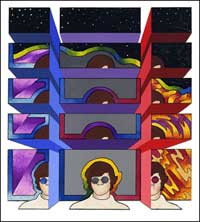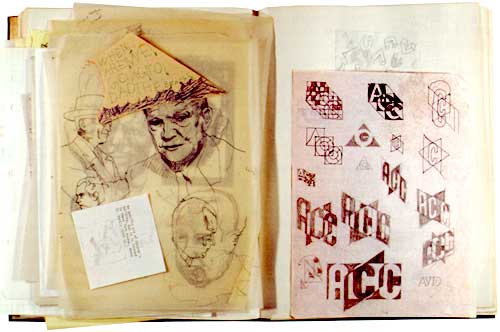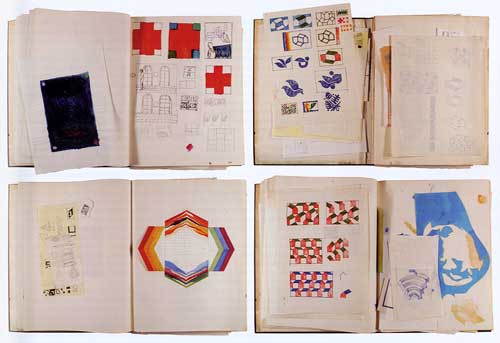This is the book that gives you a rare look into the life and vision of the late Phillip B. Meggs. Not only does it reveal the person behind The History of Graphic Design, but takes you into the workings of his art, design, teaching, and family.

You’ve read many, many reviews of Phillip Meggs books over the years, two of which received “BEST” awards in the Design Center. In 1983, Phil published the first edition his History of Graphic Design — the book that became the foundation book of most prestigious university graphic design programs. His roots in the graphic design industry ran deep and wide. In a sense, Phillip Meggs put graphic design on the map. His Revival of the Fittest masterpiece (unfortunately now out of print!) on moving classic typography into the digital era merged the scope of type and letterforms from its earliest beginnings into today’s electronic arena.
However, this book is not about the books of Phillip Meggs — its about Phil as graphic designer, professor, historian, and author. And it sets another milestone in graphic design history which should be at the top of every serious graphic designer, illustrator and typographer’s reading list. The enormous importance of this book cannot be expressed in a simple, one-page web review. No, you won’t really realize the impact of this work until you’ve savored each page — each word.
This book transcends the typical biography. It chronicles the very development and existence of a graphic design career: how much work goes into building a visual vocabulary for greatness; how much passion spreads across the daily life of a designer and the lives of those around him. It’s not just a retrospective of Phil Megg’s achievements as a historian, educator, and artist in his own right — it’s another subtle road map that sincere graphic designers and visual communicators will want to follow. No, let me rephrase that: MUST follow.
I knew Phil
 It was 1970. After a year in the “foundation” program, visual students could officially enter the communication arts department of their choice — that is if their portfolios were up to snuff. So I entered the Communication Arts & Design department where I first encountered Phil Meggs. Those were exciting times — so many social issues mingled with the cultural upheaval of the ’60s merging with art, music, politics and a ‘new’ awareness. Phil was my illustration professor. It was his challenge to drum some vision into the heads of fifteen or so arrogant, rebellious creatives who arrived in his 4-hour lab twice a week. I know he must have gone home each day thinking “how can I get rid of those kids!” But thanks to his kind way and insightful attention, he managed to inspire us and teach us.
It was 1970. After a year in the “foundation” program, visual students could officially enter the communication arts department of their choice — that is if their portfolios were up to snuff. So I entered the Communication Arts & Design department where I first encountered Phil Meggs. Those were exciting times — so many social issues mingled with the cultural upheaval of the ’60s merging with art, music, politics and a ‘new’ awareness. Phil was my illustration professor. It was his challenge to drum some vision into the heads of fifteen or so arrogant, rebellious creatives who arrived in his 4-hour lab twice a week. I know he must have gone home each day thinking “how can I get rid of those kids!” But thanks to his kind way and insightful attention, he managed to inspire us and teach us.
At right, you’ll see one of Phil’s exercises. It was to be a “color wheel” illustration which incorporated the student’s interpretation of someone they knew. When asked “who is this,” I said YOU. He wasn’t flattered, but retorted: “This doesn’t look like me.” Yes, I had given him a little more hair than he had, and added that little flip. He pressed on, and the ensuing conversation brought about mutual agreements on what constitutes “interpretation” verses “realism.” It was a good day. And, it was really the beginning of a good relationship which would last throughout my school years. Nearly three decades later I met back up with Phil on a transcripts issue involving my acceptance as instructor in JMU’s Art department. Phil gladly ‘remembered’ me and fortunately filled in the blanks in my transcript which had been mysteriously left blank so many years earlier. That was the last time I had the pleasure of speaking with Phil. Two years later, he was gone.
Making Graphic Design History
 It’s all about discipline, and how one might aspire to achieve the true level of graphic designer. Contributed essays by such greats as Steven Heller, R. Roger Remington and Roy McKelvey Roy McKelvey provide a clear look into Phil’s vision and works. Heartfelt writings by Bill Meggs and Elizabeth Meggs share the human in Phil. The warm and rich remembrance by his wife, Libby (a talented and respected illustrator) brings us all closer to the real person who was Phil Meggs. I’ve read those passages again and again.
It’s all about discipline, and how one might aspire to achieve the true level of graphic designer. Contributed essays by such greats as Steven Heller, R. Roger Remington and Roy McKelvey Roy McKelvey provide a clear look into Phil’s vision and works. Heartfelt writings by Bill Meggs and Elizabeth Meggs share the human in Phil. The warm and rich remembrance by his wife, Libby (a talented and respected illustrator) brings us all closer to the real person who was Phil Meggs. I’ve read those passages again and again.
The teaching part of the book shows you dozens of examples of Phil’s work — superb graphic design, as well as his scrap books, swipe files and sketch books. It’s a treasure trove of insight into how a creative and imaginative mind accumulates ideas, then forges them into new communications. Some of the examples shown will share his very thought processes on logos, layouts and even paintings. If you’ve accumulated your own “swipe” files, you’ll know exactly what I’m talking about and you’ll love it! If you’re new to the term, boy have we got a (visual) treat for you!
Daughter Elizabeth relates: “Dad’s broad knowledge of the lives and backgrounds of historically significant designers and artists revealed that many factors people often think of as obstacles to do doing great and noteworthy work are not real obsticals at all.”
You come to believe that statement as you read through the other essays and then Phil’s selected writings and lectures — an education in themselves. Phil introduced me to Marshall McLuhan. It had been required reading in VCU’s Foundation program, but hey — there were much more exciting things to do in Richmond those days than read, right? But Phil’s love and admiration for the concepts embedded in McCluhan inspired me (the non-reader) to actually pick up the book, then learn to appreciate McCluhan’s works as well. Phil wrote: “in a post-McCluhan era the potential is limited only by the intelligence and imagination of the artist.”

That’s the whole point of studying this retrospective of Phil Megg’s achievements as a graphic designer, historian, educator, and artist. His lasting influence on the graphic arts makes the profession better. His influence on his students, hopefully, will be carried forward by their students, and the students who follow.
It doesn’t matter if you never knew Phil. It only matters if you are sincerely interested in graphic arts and design as a discipline, a craft and a skill. The book is most important for those who wish to see where real vision can go — what it can do, and what it can accomplish. For those of us who were lucky enough to have known Phil, the book will become a treasure.
I won’t list the price. This information is priceless. So even if you had to spend 60-bucks, or $50-bucks, it’s a bargain!
MEGGS: Making Graphic Design History
Hardcover: 256 pages, Published by Wiley; Dimensions: 9.8 x 7.4 x 1 inches.
But don’t put it off. The way books go out of print these days, you may miss your chance.
Thanks for reading!

